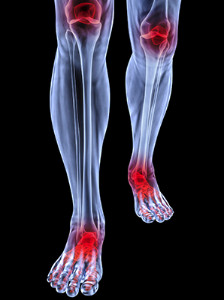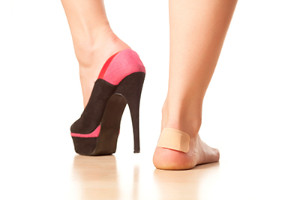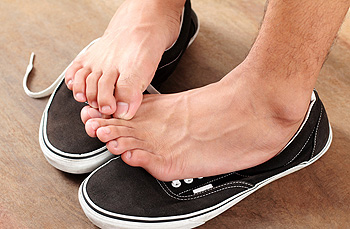Items filtered by date: March 2020
Can Arthritis Affect the Feet?
 Arthritis is considered to be a condition that can affect the bones of the feet. This can make walking painful, and daily activities may become compromised. There are different types of arthritis that may cause foot conditions to develop. Osteoarthritis may cause bunions to form, and this may be a result of cartilage that becomes damaged at the bottom of the big toe. Rheumatoid arthritis generally causes the joints in the feet to become inflamed, and the bottom of the foot may become affected. If you have pain in your feet and think it may be a form of arthritis, it is strongly suggested that you consult with a podiatrist.
Arthritis is considered to be a condition that can affect the bones of the feet. This can make walking painful, and daily activities may become compromised. There are different types of arthritis that may cause foot conditions to develop. Osteoarthritis may cause bunions to form, and this may be a result of cartilage that becomes damaged at the bottom of the big toe. Rheumatoid arthritis generally causes the joints in the feet to become inflamed, and the bottom of the foot may become affected. If you have pain in your feet and think it may be a form of arthritis, it is strongly suggested that you consult with a podiatrist.
Arthritis can be a difficult condition to live with. If you are seeking treatment, contact one of our podiatrists from Sayville Foot Care. Our doctors can provide the care you need to keep you pain-free and on your feet.
Arthritic Foot Care
Arthritis is a term that is commonly used to describe joint pain. The condition itself can occur to anyone of any age, race, or gender, and there are over 100 types of it. Nevertheless, arthritis is more commonly found in women compared to men, and it is also more prevalent in those who are overweight. The causes of arthritis vary depending on which type of arthritis you have. Osteoarthritis for example, is often caused by injury, while rheumatoid arthritis is caused by a misdirected immune system.
Symptoms
- Swelling
- Pain
- Stiffness
- Decreased Range of Motion
Arthritic symptoms range in severity, and they may come and go. Some symptoms stay the same for several years but could potentially get worse with time. Severe cases of arthritis can prevent its sufferers from performing daily activities and make walking difficult.
Risk Factors
- Occupation – Occupations requiring repetitive knee movements have been linked to osteoarthritis
- Obesity – Excess weight can contribute to osteoarthritis development
- Infection – Microbial agents can infect the joints and trigger arthritis
- Joint Injuries – Damage to joints may lead to osteoarthritis
- Age – Risk increases with age
- Gender –Most types are more common in women
- Genetics – Arthritis can be hereditary
If you suspect your arthritis is affecting your feet, it is crucial that you see a podiatrist immediately. Your doctor will be able to address your specific case and help you decide which treatment method is best for you.
If you have any questions, please feel free to contact our office located in Sayville, NY . We offer the newest diagnostic and treatment technologies for all your foot care needs.
Possible Causes of an Ingrown Toenail
 Patients who have experienced an ingrown toenail are often aware of the pain and discomfort that typically accompanies this condition. It happens when the nail grows into the outer edges of the surrounding skin, generally affecting the big toe. There are several reasons why this may occur. These can consist of trimming the toenails incorrectly, and wearing shoes that do not have adequate room for the toes to move freely in. Additionally, this ailment may occur if there has been a toe injury. Moderate relief may be found when the foot is soaked in warm water, as this may help to soften the affected area. If the toenail becomes infected, it is suggested that you seek the counsel of a podiatrist as soon as possible, so they can properly diagnose this condition and begin the correct treatment.
Patients who have experienced an ingrown toenail are often aware of the pain and discomfort that typically accompanies this condition. It happens when the nail grows into the outer edges of the surrounding skin, generally affecting the big toe. There are several reasons why this may occur. These can consist of trimming the toenails incorrectly, and wearing shoes that do not have adequate room for the toes to move freely in. Additionally, this ailment may occur if there has been a toe injury. Moderate relief may be found when the foot is soaked in warm water, as this may help to soften the affected area. If the toenail becomes infected, it is suggested that you seek the counsel of a podiatrist as soon as possible, so they can properly diagnose this condition and begin the correct treatment.
Ingrown toenails can become painful if they are not treated properly. For more information about ingrown toenails, contact one of our podiatrists of Sayville Foot Care. Our doctors can provide the care you need to keep you pain-free and on your feet.
Ingrown Toenails
Ingrown toenails occur when a toenail grows sideways into the bed of the nail, causing pain, swelling, and possibly infection.
Causes
- Bacterial infections
- Improper nail cutting such as cutting it too short or not straight across
- Trauma to the toe, such as stubbing, which causes the nail to grow back irregularly
- Ill-fitting shoes that bunch the toes too close together
- Genetic predisposition
Prevention
Because ingrown toenails are not something found outside of shoe-wearing cultures, going barefoot as often as possible will decrease the likeliness of developing ingrown toenails. Wearing proper fitting shoes and using proper cutting techniques will also help decrease your risk of developing ingrown toenails.
Treatment
Ingrown toenails are a very treatable foot condition. In minor cases, soaking the affected area in salt or antibacterial soaps will not only help with the ingrown nail itself, but also help prevent any infections from occurring. In more severe cases, surgery is an option. In either case, speaking to your podiatrist about this condition will help you get a better understanding of specific treatment options that are right for you.
If you have any questions please feel free to contact our office located in Sayville, NY . We offer the newest diagnostic and treatment technologies for all your foot and ankle needs.
Painful Foot Conditions May Come From Wearing High Heels
 Many women enjoy wearing high heels. This type of shoe adds height to the body, and may help the legs and feet to appear slender. However, research has indicated there may be a price to pay from wearing high heels. If they are frequently worn, the feet may feel tired, which can affect your overall daily performance. Additionally, foot conditions can develop as well, including hammertoes and bunions. These conditions typically form as a result of having inadequate room for the toes to move freely in. Blisters and calluses can also gradually develop due to wearing high heels. It may help to alternate wearing high heels with a pair of flat shoes throughout the week, as this may prevent ingrown toenails from forming. If you would like more information about the effect high heels can have on the feet, please consult with a podiatrist.
Many women enjoy wearing high heels. This type of shoe adds height to the body, and may help the legs and feet to appear slender. However, research has indicated there may be a price to pay from wearing high heels. If they are frequently worn, the feet may feel tired, which can affect your overall daily performance. Additionally, foot conditions can develop as well, including hammertoes and bunions. These conditions typically form as a result of having inadequate room for the toes to move freely in. Blisters and calluses can also gradually develop due to wearing high heels. It may help to alternate wearing high heels with a pair of flat shoes throughout the week, as this may prevent ingrown toenails from forming. If you would like more information about the effect high heels can have on the feet, please consult with a podiatrist.
High heels have a history of causing foot and ankle problems. If you have any concerns about your feet or ankles, contact one of our podiatrists from Sayville Foot Care. Our doctors can provide the care you need to keep you pain-free and on your feet.
Effects of High Heels on the Feet
High heels are popular shoes among women because of their many styles and societal appeal. Despite this, high heels can still cause many health problems if worn too frequently.
Which Parts of My Body Will Be Affected by High Heels?
- Ankle Joints
- Achilles Tendon – May shorten and stiffen with prolonged wear
- Balls of the Feet
- Knees – Heels cause the knees to bend constantly, creating stress on them
- Back – They decrease the spine’s ability to absorb shock, which may lead to back pain. The vertebrae of the lower back may compress.
What Kinds of Foot Problems Can Develop from Wearing High Heels?
- Corns
- Calluses
- Hammertoe
- Bunions
- Morton’s Neuroma
- Plantar Fasciitis
How Can I Still Wear High Heels and Maintain Foot Health?
If you want to wear high heeled shoes, make sure that you are not wearing them every day, as this will help prevent long term physical problems. Try wearing thicker heels as opposed to stilettos to distribute weight more evenly across the feet. Always make sure you are wearing the proper shoes for the right occasion, such as sneakers for exercising. If you walk to work, try carrying your heels with you and changing into them once you arrive at work. Adding inserts to your heels can help cushion your feet and absorb shock. Full foot inserts or metatarsal pads are available.
If you have any questions please feel free to contact our office located in Sayville, NY . We offer the newest diagnostic and treatment technologies for all your foot and ankle needs.
Arthritis Can Cause Pain in the Feet and Ankles
What Is a Blister?
 Blisters on the feet typically develop as a result of excessive friction, and can cause pain and discomfort. It may help to protect the feet while participating in running and jumping activities, and this can be accomplished by wearing shoes and socks that fit correctly. A blister is defined as a small sac that is filled with fluid. This protects the damaged and raw area as the healing process occurs. It will generally drain on its own once new skin has formed. It may be helpful to protect the blister with a soft bandage as it heals, as this may enable you to continue daily activities. If you have developed a blister on your foot that is bothersome, or has become infected, it is suggested that you speak with a podiatrist who can help you manage this condition.
Blisters on the feet typically develop as a result of excessive friction, and can cause pain and discomfort. It may help to protect the feet while participating in running and jumping activities, and this can be accomplished by wearing shoes and socks that fit correctly. A blister is defined as a small sac that is filled with fluid. This protects the damaged and raw area as the healing process occurs. It will generally drain on its own once new skin has formed. It may be helpful to protect the blister with a soft bandage as it heals, as this may enable you to continue daily activities. If you have developed a blister on your foot that is bothersome, or has become infected, it is suggested that you speak with a podiatrist who can help you manage this condition.
Blisters are prone to making everyday activities extremely uncomfortable. If your feet are hurting, contact one of our podiatrists of Sayville Foot Care. Our doctors can provide the care you need to keep you pain-free and on your feet.
Foot Blisters
Foot blisters develop as a result of constantly wearing tight or ill-fitting footwear. This happens due to the constant rubbing from the shoe, which can often lead to pain.
What Are Foot Blisters?
A foot blister is a small fluid-filled pocket that forms on the upper-most layer of the skin. Blisters are filled with clear fluid and can lead to blood drainage or pus if the area becomes infected.
How Do Blisters Form?
Blisters on the feet are often the result of constant friction of skin and material, usually by shoe rubbing. Walking in sandals, boots, or shoes that don’t fit properly for long periods of time can result in a blister. Having consistent foot moisture and humidity can easily lead to blister formation.
Prevention & Treatment
It is important to properly care for the affected area in order to prevent infection and ease the pain. Do not lance the blister and use a Band-Aid to provide pain relief. Also, be sure to keep your feet dry and wear proper fitting shoes. If you see blood or pus in a blister, seek assistance from a podiatrist.
If you have any questions, please feel free to contact our office located in Sayville, NY . We offer the newest diagnostic and treatment technologies for all your foot care needs.
How to Heal Your Athlete’s Foot
 A type of skin condition that is caused by fungus is called athlete's foot. This ailment may develop if you don’t wear protective footwear in warm or moist environments. Places like communal showers, locker rooms, and swimming pools, are all areas in which this condition can be spread if the proper precautions are not taken. The best way to help prevent this infection is to avoid walking around barefoot, as well as maintaining good hygiene. Some patients who have developed athlete’s foot have noticed the skin between their toes become scaly, dry, and itchy. Others have also experienced inflammation and cracking of the skin. If left untreated, this condition may spread to other areas of the feet, such as the toenails. For more information on how to treat and heal this condition, it is suggested that you consult with a podiatrist for professional care.
A type of skin condition that is caused by fungus is called athlete's foot. This ailment may develop if you don’t wear protective footwear in warm or moist environments. Places like communal showers, locker rooms, and swimming pools, are all areas in which this condition can be spread if the proper precautions are not taken. The best way to help prevent this infection is to avoid walking around barefoot, as well as maintaining good hygiene. Some patients who have developed athlete’s foot have noticed the skin between their toes become scaly, dry, and itchy. Others have also experienced inflammation and cracking of the skin. If left untreated, this condition may spread to other areas of the feet, such as the toenails. For more information on how to treat and heal this condition, it is suggested that you consult with a podiatrist for professional care.
Athlete’s foot is an inconvenient condition that can be easily reduced with the proper treatment. If you have any concerns about your feet and ankles, contact one of our podiatrists from Sayville Foot Care. Our doctors will treat your foot and ankle needs.
Athlete’s Foot: The Sole Story
Athlete's foot, also known as tinea pedis, can be an extremely contagious foot infection. It is commonly contracted in public changing areas and bathrooms, dormitory style living quarters, around locker rooms and public swimming pools, or anywhere your feet often come into contact with other people.
Solutions to Combat Athlete’s Foot
- Hydrate your feet by using lotion
- Exfoliate
- Buff off nails
- Use of anti-fungal products
- Examine your feet and visit your doctor if any suspicious blisters or cuts develop
Athlete’s foot can cause many irritating symptoms such as dry and flaking skin, itching, and redness. Some more severe symptoms can include bleeding and cracked skin, intense itching and burning, and even pain when walking. In the worst cases, Athlete’s foot can cause blistering as well. Speak to your podiatrist for a better understanding of the different causes of Athlete’s foot, as well as help in determining which treatment options are best for you.
If you have any questions please feel free to contact our office located in Sayville, NY . We offer the newest diagnostic and treatment technologies for all your foot and ankle needs.

